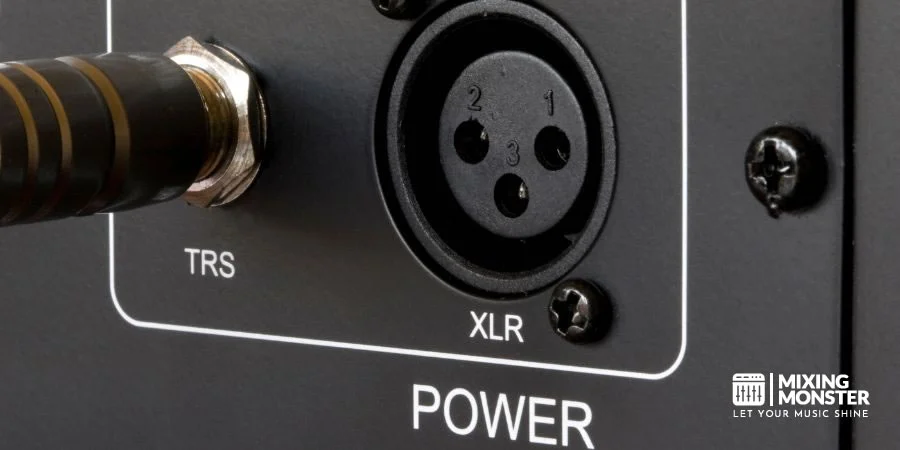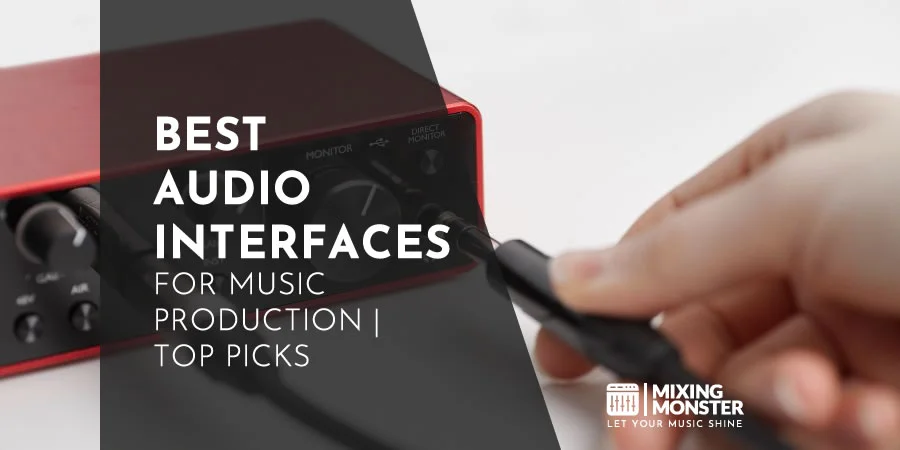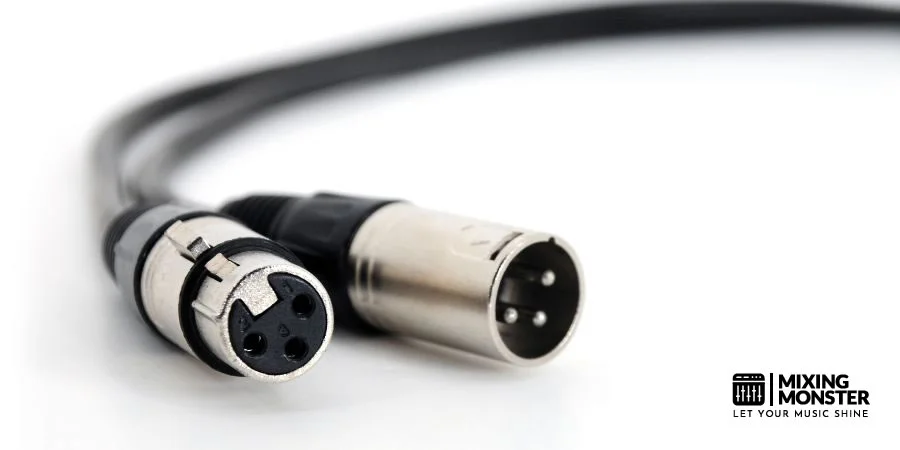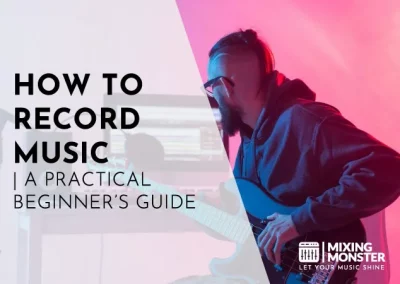Home > Blog > Recording > Recording Insights
Affiliate Disclaimer: We may earn a commission if you purchase through our links
Have you ever wondered how some microphones draw power to function and what is phantom power for microphones? Phantom power is an essential component for many microphones, particularly condenser types, enabling them to function optimally.
Phantom power for microphones is a technique that provides electrical voltage, typically 48V, to condenser microphones for them to function correctly. It is transmitted through balanced XLR cables and is crucial for powering the diaphragm and internal preamps in various microphone types.
In this article, we will demystify the concept of phantom power and describe how to effectively use it with your microphones for top-quality audio recording. So let’s explain how it works and explore its role in the modern recording environment.
Table Of Contents
1. What Is Phantom Power For Microphones?
2. Phantom Power And Microphone Types Explained
3. Phantom Power Sources Explained
4. Phantom Power And Cables Explained
5. Troubleshooting Phantom Power Issues
6. Mastering Phantom Power In Microphone Use
7. FAQ

1. What Is Phantom Power For Microphones?
Phantom power is a method of providing electrical power to microphones that require it to operate. It’s called “phantom” because the power is transmitted through the same cable that carries the audio signal without interfering with it.
Maybe you are already used to USB devices that are powered through the USB cable itself rather than using a separate power supply. The concept of phantom power for microphones is similar, the power is just submitted through the microphone XLR cable.
Phantom Power Voltage
While the standard voltage for phantom power is 48 volts, other voltage levels are used for specific purposes and microphone types. Let’s explore these different voltage levels and their applications in phantom-powered microphones.
- 48 Volts (P48)
The most common voltage level for phantom power is 48 volts, also known as P48. This voltage level is widely used in professional audio equipment and microphones, especially true condenser microphones. P48 is the standard established by the International Electrotechnical Commission (IEC), and most audio interfaces, mixers, and external phantom power supplies are designed to provide this voltage.
- 24 Volts (P24)
Although less common, some microphones and audio equipment use a 24-volt phantom power level, referred to as P24. This voltage level is sometimes found in older audio equipment or specific applications requiring lower power. It’s essential to check the microphone’s specifications to determine if it can operate at 24 volts before using this voltage level.
- 12 Volts (P12)
The 12-volt phantom power level, known as P12, is another less common voltage level used in some microphones and audio equipment. P12 is often found in battery-powered devices, such as portable field recorders or smaller audio mixers, where the lower power consumption is beneficial. As with P24, always verify the microphone’s compatibility with a 12-volt power supply before using it.
- Plug-In Power
Plug-in power is lower, typically between 3 to 5 volts, primarily for more miniature electret condenser microphones. These microphones are commonly found in portable recording devices, lavalier microphones, and camera microphones. Plug-in power is supplied through a different connector than XLR, usually a 3.5mm TRS (tip-ring-sleeve) jack.
It’s crucial to understand the voltage requirements of your microphones and provide the correct phantom power voltage to ensure optimal performance and avoid potential damage.
Always consult the manufacturer’s specifications or user manual to determine the appropriate voltage level for your microphone. Additionally, make sure your audio interface, mixer, or external phantom power supply can deliver the required voltage for your microphone.
2. Phantom Power And Microphone Types Explained
Condenser Microphones
Condenser microphones are the most common type of microphone that requires phantom power. They use a thin diaphragm and a fixed backplate to create an electrical charge, which generates the audio signal.
Electret Condenser Microphones
Electret condenser microphones have a permanently charged diaphragm, requiring only a tiny amount of external power for the internal preamp. Some electret condenser microphones can run on batteries, while others rely on phantom power.
True Condenser Microphones
True condenser microphones require an external power source to polarize the diaphragm. These microphones typically depend on phantom power to function correctly.
Dynamic Microphones
Dynamic microphones, on the other hand, do not require phantom power. They generate an audio signal using a coil and a magnet, which don’t need an external power source.
Ribbon Microphones
Most Ribbon microphones also do not require phantom power. However, there are some active ribbon mics that may need it.
Microphone Types And Phantom Power Requirements:
| Microphone Type | Phantom Power Requirement |
|---|---|
| Condenser Microphones | Require phantom power, typically 48V, to function correctly. |
| Electret Condenser Microphones | Some require phantom power, while others use batteries or plug-in power (3-5V) for their internal preamps. |
| True Condenser Microphones | Depend on phantom power, typically 48V, to polarize the diaphragm and function correctly. |
| Dynamic Microphones | Do not require phantom power. Most dynamic microphones can handle phantom power without damage but always consult the user manual. |
| Ribbon Microphones | Most do not require phantom power. However, active ribbon microphones may need phantom power for their internal preamps. Check specs. |
3. Phantom Power Sources Explained
Audio Interfaces And Mixers
Audio interfaces and mixers are the most common sources of phantom power. They usually provide 48 volts of phantom power through their XLR inputs, making connecting and powering condenser microphones easy.
Using audio interfaces and mixers with microphones that require phantom power is a common practice in both professional and home recording setups.
These devices are designed to provide the necessary power to microphones while maintaining high-quality audio performance. Let’s discuss the use of audio interfaces and mixers with phantom-powered microphones and highlight some of the most popular models that offer this feature.
Feel free to check out our current top picks for audio interfaces here:
Audio Interfaces
Audio interfaces are essential for connecting microphones to computers for recording, mixing, and processing audio. They often include built-in microphone preamps and phantom power supplies to provide the necessary voltage to condenser microphones.
Many audio interfaces offer a switch or button to activate phantom power, usually labeled as “+48V” or “Phantom.”
Audio Mixers
Audio mixers are devices used to blend multiple audio signals, including microphones, instruments, and other sound sources, into a single output. They typically feature numerous input channels with built-in preamps and phantom power, allowing you to connect and power various microphones simultaneously.
Like audio interfaces, mixers usually have a switch or button to enable phantom power for the necessary input channels.
When using phantom power with audio interfaces or mixers, it’s essential to follow a few best practices:
- Always turn off phantom power before connecting or disconnecting microphones to avoid potential damage to your equipment.
- Use balanced XLR cables to connect your phantom-powered microphones to the audio interface or mixer, as they provide better noise rejection and proper power transmission.
- Ensure that the phantom power voltage supplied by your audio interface or mixer is compatible with the microphone’s requirements, as specified by the manufacturer.
External Phantom Power Supplies
For situations where an audio interface or mixer is unavailable or lacks phantom power, external phantom power supplies can be used. These devices connect the microphone and the recording equipment, providing the necessary power for the microphone to function.
4. Phantom Power And Cables Explained
Balanced Vs. Unbalanced Cables
Phantom power requires balanced cables with three conductors: a positive, a negative, and a ground.
Balanced cables offer better noise rejection and allow longer cable runs without signal degradation. On the other hand, unbalanced cables have only two conductors and are unsuitable for transmitting phantom power. The most common type of balanced cable used for phantom power is the XLR cable.

5. Troubleshooting Phantom Power Issues
Occasionally, you may encounter issues with phantom power. Let’s take a look at some common problems and their solutions:
- No Sound Or Low Signal:
Check that the phantom power is turned on and that the voltage is sufficient for your microphone. Ensure that the microphone is connected to the correct input and that all cables are correctly connected. - Buzzing Or Hum:
This could be due to a ground loop or interference from other devices. Try using a different power outlet or using a ground lift adapter. Additionally, check for damaged cables or connectors and replace them if necessary. - Distorted Sound:
Distorted sound could be due to a damaged microphone or an overloaded preamp. Try lowering the input gain on your audio interface or mixer, and check the microphone for visible damage.
6. Mastering Phantom Power In Microphone Use
Phantom power is essential to modern audio recording, allowing condenser microphones to function correctly.
Understanding how phantom power works, the different types of microphones used, and the common issues that may arise can help you achieve the best possible recording results.
With this knowledge, you can confidently navigate the concept of phantom power and ensure that your microphones perform at their best.
7. FAQ
- Can Phantom Power Damage Dynamic Microphones?
In most cases, phantom power will not harm dynamic microphones, as their design doesn’t require an external power source. However, it’s always best to consult the microphone’s manual to ensure compatibility with phantom power. - Is Phantom Power The Same As Plug-In Power?
Phantom power and plug-in power are different. Plug-in power is typically between 3 to 5 volts and is used for smaller electret condenser microphones, such as those found in portable recorders and camera microphones. - Can I Use A Phantom Power Supply With A USB Microphone?
USB microphones have their own built-in preamp and power supply, so they do not require phantom power. Using a phantom power supply with a USB microphone is unnecessary and could damage the microphone. - Can I Use A Condenser Microphone Without Phantom Power?
If a condenser microphone requires phantom power, it will not function correctly without it. However, some condenser microphones have battery-powered options, allowing them to work without phantom power. - Do Ribbon Microphones Need Phantom Power?
Most ribbon microphones do not require phantom power, as they operate on a similar principle to dynamic microphones. However, some active ribbon microphones may need phantom power for their internal preamps. Always check the manufacturer’s specifications before applying phantom power to a ribbon microphone.




















